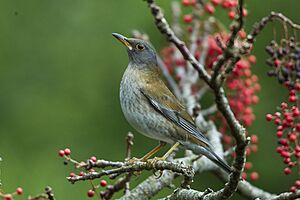Pale thrush facts for kids
Quick facts for kids Pale thrush |
|
|---|---|
 |
|
| Conservation status | |
| Scientific classification | |
| Genus: |
Turdus
|
| Species: |
pallidus
|
The pale thrush (Turdus pallidus) is a type of bird found in eastern Asia. It belongs to the thrush family. This bird is known for its shy nature. It is closely related to the eye-browed thrush and grey-backed thrush.
About the Pale Thrush's Name
Scientists give every living thing a special two-part name. This helps everyone know exactly which animal they are talking about. The pale thrush's scientific name is Turdus pallidus.
The name was first given by a German scientist named Johann Friedrich Gmelin in 1789. The word Turdus comes from Latin and means "thrush." The word pallidus also comes from Latin and means "pale" or "light-colored." So, its scientific name simply means "pale thrush." This bird does not have different types or subspecies.
What Does the Pale Thrush Look Like?
The pale thrush is about 23 centimeters (9 inches) long. Its feet are a light pinkish-brown color. The top part of its bill is grey, and the bottom part is yellow.
- Male Birds: Males have brown feathers on their back. Their head and throat are a blue-grey color. Their belly is a pale brown, getting darker on the sides. The very bottom of their belly is whitish. The main feathers on their wings and tail are dark grey.
- Female Birds: Females look a lot like the males. However, their colors are a bit duller. Their head is usually browner than the male's.
This bird also has special calls. It makes harsh chuck-chuck and see-ip sounds. When it senses danger, it makes a bubbling alarm call.
Where Do Pale Thrushes Live?
The pale thrush lives in different parts of eastern Asia.
- Breeding Areas: These birds build their nests and raise their young in places like south-east Siberia, north-east China, and Korea. They might also breed in Japan, especially on Tsushima Island.
- Migration: Pale thrushes are migratory birds. This means they travel long distances between their breeding grounds and their winter homes.
- Winter Homes: During the colder months, they fly south. They spend winter in southern and central Japan, South Korea, and southern China. Sometimes, they travel even further to places like Yunnan, Taiwan, and the Philippines.
You can find pale thrushes in many different places. They like forests, areas with thick bushes (scrub), gardens, and parks. They are quite shy birds and usually stay hidden among the trees or bushes. When they are migrating, you might see them in large groups, especially if there are lots of berries to eat.


